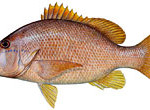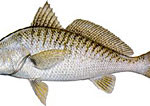
Gadidae
The family Gadidae of cods and haddocks is found primarily in the circumpolar and temperate seas of the Atlantic, Pacific and Arctic oceans, principally in the northern hemisphere. A commercially important fish, cods are normally found swimming in schools at moderate to deep depths and feed on a variety of invertebrates and other fishes. Some species are noted for their habit of long-distance migration.
One of the most common in the region is the Atlantic cod (gadus morhua), to be found in the benthopelagic zone and in brackish waters, at depths of 1 – 600m. This species is widely distributed in a variety of habitats from the shoreline to well down the continental shelf. It is omnivorous and feeds at either dawn or dusk.
Another common member of the family is the haddock (Melanogrammus aeglefinus), found at depths of 10-450m over rocks sand or gravel and feeding on small benthic organisms, including molluscs, crustaceans, echinoderms, worms and small fishes.
Most species are demersal, or benthopelagic, that is to say that they are free swimming and will tend to hover over or near the sea floor.
For identification purposes, they have three dorsal (back) fins and two anal fins, with the first dorsal just behind the head. Cods have no spines but do normally have a barbel: slender, whisker-like tactile organs extending from the head.
Those that you are most likely to see in the region are listed below, with their maximum adult length. Note that intensive fishing practices hace rendeded two of the species vulenerable as reported on the IUCN Redlist.
- Atlantic cod Gadus morhua 100cm (Vulnerable – IUCN)
- Atlantic tomcod Microgadus tomcod 38cm
- Blue whiting Micromesistius poutassou 50cm
- Haddock Melanogrammus aeglefinus 100cm (Vulnerable – IUCN)
- Polar cod Boreogadus saida 40cm
- Pollock Pollachius virens 130cm








Social Profiles